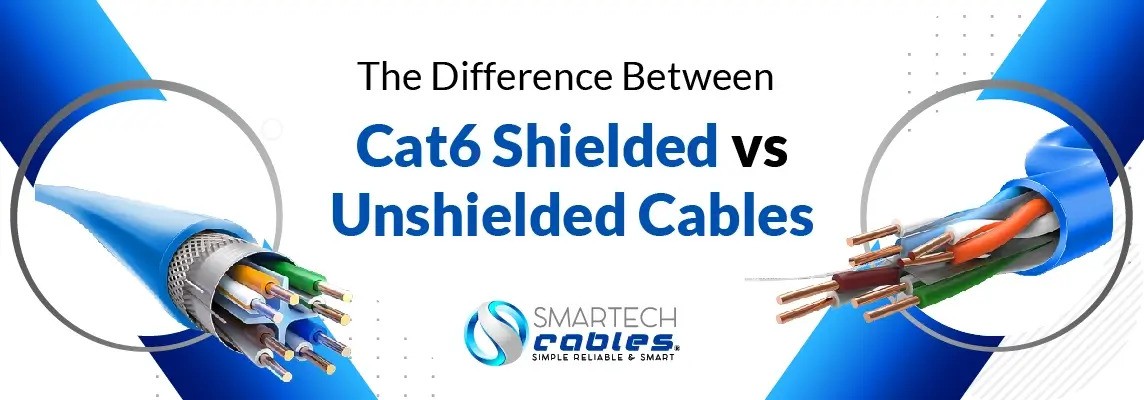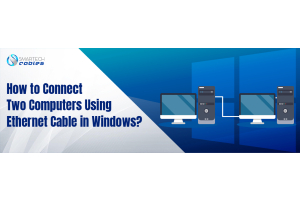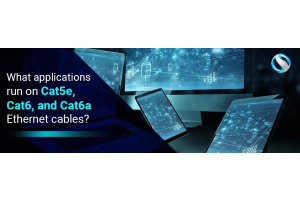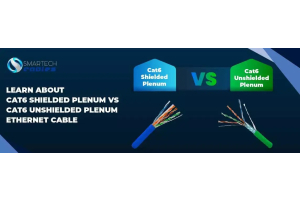The Difference Between Cat6 Shielded vs Unshielded Cables

Which is the go-to ethernet cable for all types of wired networking applications? The Cat6 cable, right? Do you know what it is and how varied its types are? Well, the cable is produced in up to 5 different variants such as the shielded Cat6, unshielded Cat6, solid/stranded, etc.
Shielded Cat6 and Unshielded Cat6 cables are the most commonly differentiated cables. They are also the most commonly used variants of the Cat6 Ethernet cable. Its shielded variant is renowned for maintaining minimum electromagnetic interference and different kinds of crosstalk in crowded networks. Similarly, the unshielded Cat6 cable is renowned for its affordability, ease of installation, and high performance.
The shielded Cat6 cable is different from the unshielded cables because of many factors.
Let’s have a detailed look at these differences.
This blog is about the difference between Cat6 shielded vs Unshielded Cables. Be sure to read until the end.
Cat6 Cable
Before we venture into explaining the differences between the shielded and unshielded Cat6 cables, let's take a moment to understand or recap what a Cat6 cable is.
So, this is the 6th category of Ethernet Cables that was rolled out to the public after the Cat5e. This cable featured more twists per unit length in the cable conductors. Moreover, a spline, also known as a wire separator is integrated between the cable conductors. This wire separator keeps the conductor pairs apart which directly translates into better performance in terms of low interference (electromagnetic).
This cable is certified by EIA/TIA and is manufactured as per the RoHS standards. Moreover, the cable can be used for all kinds of high-speed ethernet applications such as fast ethernet, gigabit ethernet, 10-gigabit ethernet, audio/video applications, online gaming/streaming, PoE, PoE+/++, etc.
Cat6 cable at its core features 4 tightly twisted pairs of 23 AWG conductors. The size of the conductors is the same in both shielded and unshielded cables. And the number of conductor pairs is also the same.
The only difference between the shielded (STP) Cat6 and unshielded (UTP) Cat6 is that the STP cable has a wire mesh or metal foil around the conductors. The UTP cables do not feature this additional protection against EMI and crosstalk, they only rely on twisted pairs of cable conductors and cable insulation.
However, note that because of this additional shielding, or lack of it thereof, causes further differences between STP and UTP cables. From the performance of the cable to its price and ease of installation, the shielding affects it.
Cat6 Unshielded Cable
Cat6 unshielded cable is more or less the basic definition of the Cat6 cable. With its unshielded conductors and a variety of cable jackets to choose from, the cable is simply any Cat6 cable.
So by definition, it has 4 twisted pairs of 23 AWG conductors that are unshielded. These conductors could be made from bare copper or copper-clad aluminum. The conductors could also be either solid or stranded. More on the type of conductor in the later parts.
The Cat6 unshielded cable is designed for use in networks with a relatively lower cable density. It could be your home or office, the important factor is the number of cables running in parallel to it.
For example, if your network has more than three cables running in parallel to each other and if you install the unshielded cable alongside them. You are going to have some interference. So in such places where the cables are crowded, avoid using this cable.
Note that unshielded cable is not entirely susceptible to interference/crosstalk. It has a built-in feature in the form of twisted pairs. That is responsible for keeping unwanted signals at bay.
Cat6 Shielded Cable
The shielding of the Cat6 shielded ethernet cable is its main highlight. This shielding can be in three forms: 1. It can be a metal foil, 2. It can be a wire mesh, and 3. It can be both a wire mesh and a metal foil - wrapped around the cable conductor.
As mentioned, the job of the shielding is to protect the cable conductor from receiving unintended signals.
What happens in wired data networks is that signals escape their media (conductor) and enter other mediums (conductors of other cables). If signals from one ethernet cable escape, the cable next to is most likely to receive it and send it further. This is known as crosstalk or external noise.
The wired data networks, therefore, need Shielded Cat6 when quite a few cables are running in parallel to each other.
There are some drawbacks of shielded ethernet cables as well. Firstly, installation is more tricky with them. And secondly, they are more expensive because of the obvious additional features. Shielded ethernet cables are stiffer than the unshielded ones which makes them rather hard to install. And as we mentioned, with the enhancement in features, the price also rises. So these cables will cost you a little more than their unshielded counterparts.
Difference between Cat6 Shielded vs Unshielded
Both the shielded and the unshielded Cat6 cables have the same core. Except, the shielded ones feature an extra layer or two of protection against interference. Although the shield is the only difference between the cables, it, however, causes distinctions in the performance of the cable. Let’s take a detailed look at each difference caused by the shielding in the Cat6 cable.
Speed
In the unshielded cable, EMI and interference can cause slower transmission of the actual signals. But in shielded cables, the speed can be maintained fairly because of the lesser interference.
Overall, shielded cables are better at keeping the speed intact as compared to unshielded Cat6 cables. So if speed is a big concern for you, you might want to get the unshielded cable.
Bandwidth
Bandwidth is the total amount of data that can be transmitted across the cable in unit time (one second). In shielded cables, it is also maintained quite well, like the speed. However, in the unshielded ones, some of the bandwidth is consumed by interference and unintended signals which occupy the space your cables should be occupying.
Note that although the unshielded cables will have a less efficient bandwidth, the Cat6 cable has quite enough capacity to support almost any kind of requirement. Simply put, you will rarely run out of bandwidth, if at all.
Efficiency
Let's first find out what efficiency in ethernet cables is. The cable can deliver on its specifications. In other words, it is the measure of how much a cable promises to deliver and how much it does.
The Cat6 cable has a 1 GBit/s data transfer rate at a maximum run length of 100 meters. Now, if the cable can deliver exactly 1 GBit/s or more over a 100-meter run length, it is said to be highly efficient. Failing to do so means the cable is not so efficient.
We just discussed the effect of shielding on the speed and bandwidth of the Cat6 cable. And concluded that having the shielding means better speed and bandwidth efficiency as opposed to not having the shielding. This is the general, overall efficiency of shielded and unshielded Cat6 cables.
EMI and Crosstalk
Electromagnetic interference in a cable is the signals that are emitted from cables in its vicinity. When the Cat6 cable is shielded, this interference is less likely to interfere with its signal transmission. It is either completely blocked or reflected.
But in unshielded cables, EMI and various kinds of crosstalk are more likely to affect the performance of the cable.
Cost
How the STP and UTP Cat6 cable differ cost-wise is a simple question to answer.
Because the shielding is additional material, the cable will cost an additional amount.
Also, note that this one-time additional cost will pay back in the long run. The cost of the shielded cables is worth it.
Solid/Stranded Conductor
Shielded and unshielded cables have the same conductors. Any shielded cable can have the same conductor as any unshielded Cat6 cable.
The conductors can be solid or stranded too. Solid conductors are made from a single piece of material whereas stranded conductors are made from multiple strands of the material.
For outdoor runs, solid Cat6 cables are more viable whereas for indoors, the stranded ones are better.
Ease of installation
Well, the performance of the Cat6 cable is an important factor, how easy it is to install cannot be ignored either.
Shielded Cat6 cable is rather tricky to install because of its stiffness caused by the shielding material underneath its jacket. Whereas the unshielded cable is fairly smooth to install. For outdoors and indoors, the unshielded cable can be installed very easily, especially if the cable is packaged on an easy-to-pull box.
The difficulty of installing the shielded cable can also be overcome by using a cable that is packaged on a kink-free easy-pull box or a sturdy wooden spool.
Lifespan
How long a cable will last is dependent on the conductor and the jacket. Shielding of the cable has little if anything to do with it.
So both the shielded and the unshielded Cat6 cables will most likely last the same amount of time provided they are used in the same conditions.
One exception here is the shielded cable. The cable, when turned at sharp edges, is more likely to remain undamaged.
Smartech Cables
For innovative ethernet cables or accessories, check out Smartech Cables. We are the industry leader in manufacturing and distributing networking cables and accessories of the highest standards. Our products exceed the industry standards and we are offering competitive market prices. If you need help, our professional customer support team is available at sales@smartechcables.com.






